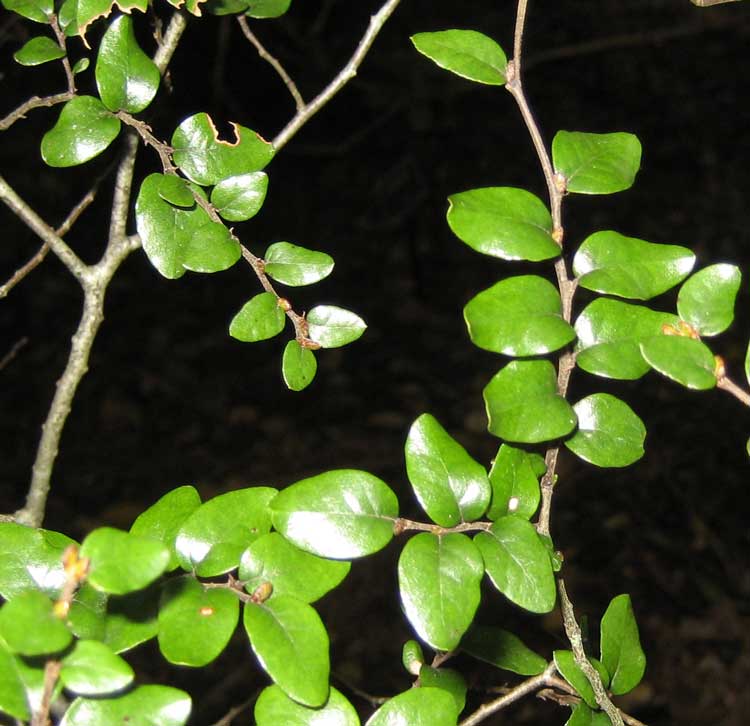
Nothofagus solandri var. cliffortioides (*)
Classification System: APG IV
Superregnum: Eukaryota
Regnum: Plantae
Cladus: Angiosperms
Cladus: Eudicots
Cladus: Core eudicots
Cladus: Rosids
Cladus: Eurosids I
Ordo: Fagales
Familia: Nothofagaceae
Genus: Nothofagus
Subgenus: Nothofagus subg. Fuscospora
Species: Nothofagus solandri
Name
Nothofagus solandri (Hook.f.) Oerst., Bidr. Egefam. 25. (1871)
Synonyms
Basionym
Fagus solandri Hook.f., Hooker's Icon. Pl. 7: t. 639, t. 816 (1844)
Homotypic
Fuscospora solandri (Hook.f.) Heenan & Smissen, Phytotaxa 146: 14 (2013)
Heterotypic
Cliffortioides oblongata Dryand., Hooker's Icon. Pl. 7: t. 689 (1844), pro syn.
Myrtilloides cinerascens Banks & Sol. ex Hook., Hooker's Icon. Pl. 7: t. 639 (1844)
Nothofagus × soltruncata Cockayne in L.Cockayne & E.P.Turner, Trees New Zealand: 144 (1928)
References
Oersted, A.S. 1871. Bidrag til Kundskab om Egefamilien 25. et Kongel. Danske Vidensk. Selsk. Skr., Naturvidensk. Math. Afd. ser. 5, 9:355. 1873
Govaerts, R. et al. 2022. Nothofagus solandri in World Checklist of Selected Plant Families. The Board of Trustees of the Royal Botanic Gardens, Kew. Published online. Accessed: 2022 Apr. 3. Reference page.
International Plant Names Index. 2022. Nothofagus solandri. Published online. Accessed: Apr. 3 2022.
USDA, ARS, Germplasm Resources Information Network. Nothofagus solandri in the Germplasm Resources Information Network (GRIN), U.S. Department of Agriculture Agricultural Research Service. Accessed: 07-Oct-06.
Vernacular names
English: Black Beech
suomi: Mustaetelänpyökki
Nothofagus solandri var. solandri, commonly called black beech, is a variety of the tree species Nothofagus solandri, endemic to New Zealand. Black beech occurs on both the North and the South Island at low altitudes up to the mountains. The other variety of N. solandri is called mountain beech or Nothofagus solandri var. cliffortioides, and grows at higher altitudes than black beech. In New Zealand the taxon is called Fuscospora solandri.[1]
Black beech is a medium-sized evergreen tree growing to 27 m tall. The leaves are oppositely arranged, ovoid, 10 mm long and 5 mm broad, with smooth margins.
Black beech is known as black beech because it is prone to a sooty mold which covers the trunk and branches. This, in turn, is the result of a scale insect which sucks sap from the tree, and excretes honeydew, a sweet liquid, in small droplets (less than 1 mm diameter) on the end of stalks. This feeds the sooty mold, and also forms a valuable high-energy food source for various birds and insects including the kaka. The infestation is common and does not appear to harm the tree.
Black beech and mountain beech have both been planted in Great Britain, and mountain beech has shown better cold tolerance than black beech in locations such as Scotland.[2]
Hybrids
Black beech is known to hybridise freely with mountain beech (Nothofagus solandri var. cliffortioides]]) where the two species co-exist, and in some places the hybrids may form complex introgressive hybrid swarms.[3]
Black beech hybridises with hard beech (Nothofagus truncata) to form the hybrid species Nothofagus × apiculata.[1]
Black beech hybridises with red beech (Nothofagus fusca) to form the hybrid species Nothofagus × dubia.[1]
References
HEENAN, PETER B.; SMISSEN, ROB D. (2013). "Revised circumscription of Nothofagus and recognition of the segregate genera Fuscospora, Lophozonia, and Trisyngyne (Nothofagaceae)". Phytotaxa. 146 (1): 131. doi:10.11646/phytotaxa.146.1.1. Retrieved 31 May 2015.
"Nothofagus solandri in Great Britain".
"Fuscospora solandri". New Zealand Plant Conservation Network. Retrieved 31 May 2015.
Retrieved from "http://en.wikipedia.org/"
All text is available under the terms of the GNU Free Documentation License

